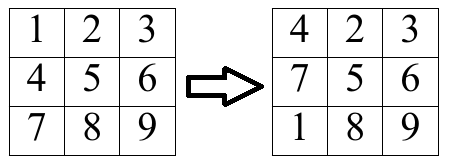Obtain a Permutation
题意翻译
## 题意翻译
给你一个由$1$到$2\times 10^5$的整数组成的$n\times m$矩阵
在一步操作中,你可以:
- 选择矩阵中的**任何**一个元素并将其变成$1$到$n\times m$(含)中的**任意**整数
- 选择一列并将其周期性的向上移动一个单元格
周期性的向上移动一个单元格意味着你选择一个$j (1\le j\le m)$并且**同时**进行如下操作:$a_{1, j} := a_{2, j}, a_{2, j} := a_{3, j}, \dots, a_{n, j} := a_{1, j}$

上面是一个例子
你想要用最少的操作次数使得这个矩阵看起来像这样:

也就是说,你的目标是用**最少的操作次数**得到这样一个矩阵,使得
$a_{1, 1} = 1, a_{1, 2} = 2, \dots, a_{1, m} = m, a_{2, 1} = m + 1, a_{2, 2} = m + 2, \dots, a_{n, m} = n \cdot m$
## 数据范围
$1 \le n, m \le 2 \cdot 10^5, n \cdot m \le 2 \cdot 10^5$
$1 \le a_{i, j} \le 2 \cdot 10^5$
题目描述
You are given a rectangular matrix of size $ n \times m $ consisting of integers from $ 1 $ to $ 2 \cdot 10^5 $ .
In one move, you can:
- choose any element of the matrix and change its value to any integer between $ 1 $ and $ n \cdot m $ , inclusive;
- take any column and shift it one cell up cyclically (see the example of such cyclic shift below).
A cyclic shift is an operation such that you choose some $ j $ ( $ 1 \le j \le m $ ) and set $ a_{1, j} := a_{2, j}, a_{2, j} := a_{3, j}, \dots, a_{n, j} := a_{1, j} $ simultaneously.
 Example of cyclic shift of the first column You want to perform the minimum number of moves to make this matrix look like this:
In other words, the goal is to obtain the matrix, where $ a_{1, 1} = 1, a_{1, 2} = 2, \dots, a_{1, m} = m, a_{2, 1} = m + 1, a_{2, 2} = m + 2, \dots, a_{n, m} = n \cdot m $ (i.e. $ a_{i, j} = (i - 1) \cdot m + j $ ) with the minimum number of moves performed.
输入输出格式
输入格式
The first line of the input contains two integers $ n $ and $ m $ ( $ 1 \le n, m \le 2 \cdot 10^5, n \cdot m \le 2 \cdot 10^5 $ ) — the size of the matrix.
The next $ n $ lines contain $ m $ integers each. The number at the line $ i $ and position $ j $ is $ a_{i, j} $ ( $ 1 \le a_{i, j} \le 2 \cdot 10^5 $ ).
输出格式
Print one integer — the minimum number of moves required to obtain the matrix, where $ a_{1, 1} = 1, a_{1, 2} = 2, \dots, a_{1, m} = m, a_{2, 1} = m + 1, a_{2, 2} = m + 2, \dots, a_{n, m} = n \cdot m $ ( $ a_{i, j} = (i - 1)m + j $ ).
输入输出样例
输入样例 #1
3 3
3 2 1
1 2 3
4 5 6输出样例 #1
6输入样例 #2
4 3
1 2 3
4 5 6
7 8 9
10 11 12输出样例 #2
0输入样例 #3
3 4
1 6 3 4
5 10 7 8
9 2 11 12输出样例 #3
2说明
In the first example, you can set $ a_{1, 1} := 7, a_{1, 2} := 8 $ and $ a_{1, 3} := 9 $ then shift the first, the second and the third columns cyclically, so the answer is $ 6 $ . It can be shown that you cannot achieve a better answer.
In the second example, the matrix is already good so the answer is $ 0 $ .
In the third example, it is enough to shift the second column cyclically twice to obtain a good matrix, so the answer is $ 2 $ .